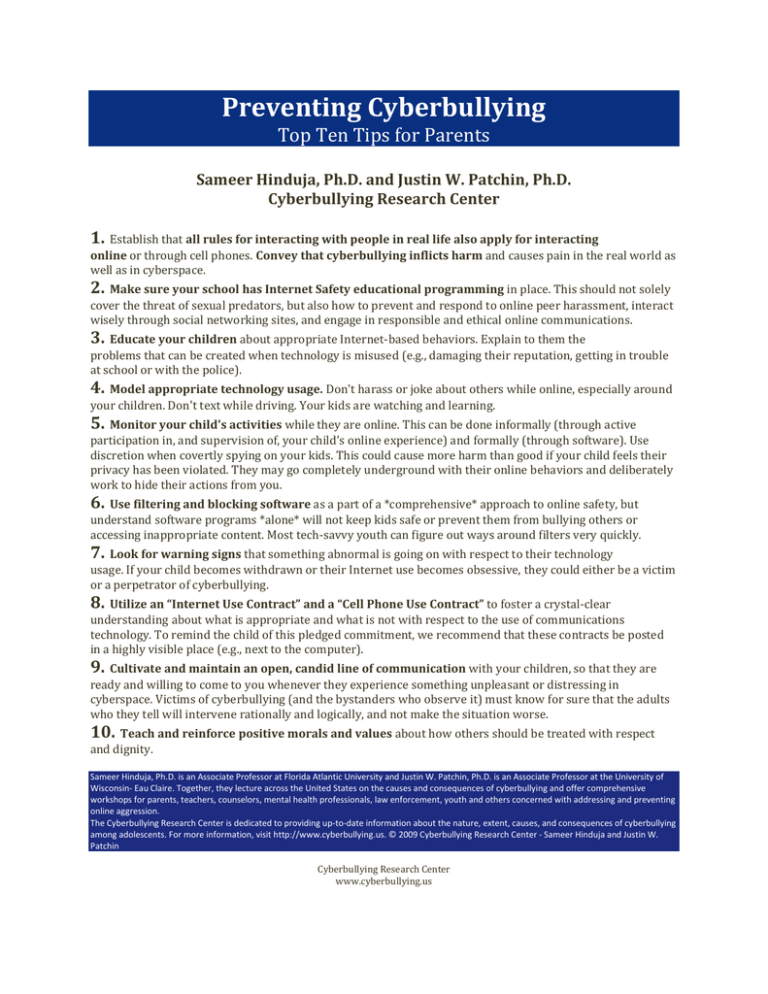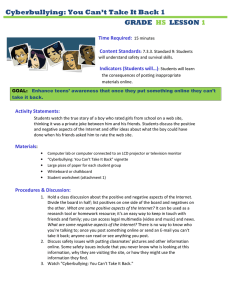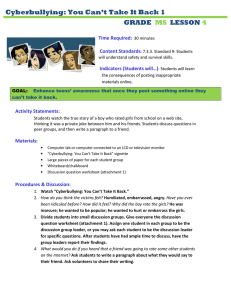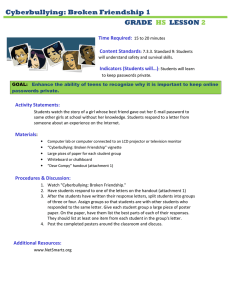Preventing Cyberbullying Top Ten Tips for Parents 1.
advertisement

Preventing Cyberbullying Top Ten Tips for Parents Sameer Hinduja, Ph.D. and Justin W. Patchin, Ph.D. Cyberbullying Research Center 1. Establish that all rules for interacting with people in real life also apply for interacting online or through cell phones. Convey that cyberbullying inflicts harm and causes pain in the real world as well as in cyberspace. 2. Make sure your school has Internet Safety educational programming in place. This should not solely cover the threat of sexual predators, but also how to prevent and respond to online peer harassment, interact wisely through social networking sites, and engage in responsible and ethical online communications. 3. Educate your children about appropriate Internet‐based behaviors. Explain to them the problems that can be created when technology is misused (e.g., damaging their reputation, getting in trouble at school or with the police). 4. Model appropriate technology usage. Don't harass or joke about others while online, especially around your children. Don't text while driving. Your kids are watching and learning. 5. Monitor your child's activities while they are online. This can be done informally (through active participation in, and supervision of, your child’s online experience) and formally (through software). Use discretion when covertly spying on your kids. This could cause more harm than good if your child feels their privacy has been violated. They may go completely underground with their online behaviors and deliberately work to hide their actions from you. 6. Use filtering and blocking software as a part of a *comprehensive* approach to online safety, but understand software programs *alone* will not keep kids safe or prevent them from bullying others or accessing inappropriate content. Most tech‐savvy youth can figure out ways around filters very quickly. 7. Look for warning signs that something abnormal is going on with respect to their technology usage. If your child becomes withdrawn or their Internet use becomes obsessive, they could either be a victim or a perpetrator of cyberbullying. 8. Utilize an “Internet Use Contract” and a “Cell Phone Use Contract” to foster a crystal‐clear understanding about what is appropriate and what is not with respect to the use of communications technology. To remind the child of this pledged commitment, we recommend that these contracts be posted in a highly visible place (e.g., next to the computer). 9. Cultivate and maintain an open, candid line of communication with your children, so that they are ready and willing to come to you whenever they experience something unpleasant or distressing in cyberspace. Victims of cyberbullying (and the bystanders who observe it) must know for sure that the adults who they tell will intervene rationally and logically, and not make the situation worse. 10. Teach and reinforce positive morals and values about how others should be treated with respect and dignity. Sameer Hinduja, Ph.D. is an Associate Professor at Florida Atlantic University and Justin W. Patchin, Ph.D. is an Associate Professor at the University of Wisconsin‐ Eau Claire. Together, they lecture across the United States on the causes and consequences of cyberbullying and offer comprehensive workshops for parents, teachers, counselors, mental health professionals, law enforcement, youth and others concerned with addressing and preventing online aggression. The Cyberbullying Research Center is dedicated to providing up‐to‐date information about the nature, extent, causes, and consequences of cyberbullying among adolescents. For more information, visit http://www.cyberbullying.us. © 2009 Cyberbullying Research Center ‐ Sameer Hinduja and Justin W. Patchin Cyberbullying Research Center www.cyberbullying.us Responding to Cyberbullying Top Ten Tips for Parents Sameer Hinduja, Ph.D. and Justin W. Patchin, Ph.D. Cyberbullying Research Center 1. Make sure your child feels (and is) safe and secure, and convey unconditional support. Parents must demonstrate to their children through words and actions that they both desire the same end result: that the cyberbullying stop and that life does not become even more difficult. 2. Thoroughly investigate the situation so that you fully understand what happened, who was involved, and how it all started. Getting to the root cause of the behavior will help you develop an appropriate response – whether your child was the target or the bully. 3. Refrain from immediately banning access to instant messaging, e‐mail, social networking Web sites, a cell phone, or the Internet in general. This strategy neither addresses the underlying interpersonal conflict, nor eliminates current or future instances of victimization. It will also likely close off a candid line of communication and promote overt defiance of the ban among children accustomed to frequent online access. 4. When deemed appropriate, contact the parents of the cyberbully, or schedule a meeting with school administrators (or a trusted teacher) to discuss the matter. 5. When necessary, contact and work with the Internet Service Provider, Cell Phone Service Provider, or Content Provider (MySpace or Facebook, for example) to investigate the issue or remove the offending material. 6. When appropriate, contact the police. For example, law enforcement should be contacted when physical threats are involved or a crime has possibly been committed (such as capturing, sending, or posting sexually‐explicit images of minors). 7. Talk to other parents through school and community organizations to raise awareness and determine the extent to which cyberbullying is occurring among other kids in the area (chances are, it is). Alert other parents if your child is being cyberbullied, as this might prompt them to inquire about the online experiences of their own kids. 8. Apply firm consequences if your child engages in cyberbullying behaviors, and escalate punishment if the behaviors repeat or are particularly serious, so that your child realizes the unacceptability of harassing others online. 9. Work with your child’s school. They are trained to deal with these kinds of problems. If you feel like you aren’t getting anywhere, consult with educators from other schools. 10. Talk to your child about the problem in detail, and make sure you fully understand the roles of both parties, the motivations, and how technology was misused. Work together with the child to arrive at a mutually‐agreeable course of action, including soliciting their input for resolving the situation (what would *they* like to see happen?). Sameer Hinduja, Ph.D. is an Associate Professor at Florida Atlantic University and Justin W. Patchin, Ph.D. is an Associate Professor at the University of Wisconsin‐ Eau Claire. Together, they lecture across the United States on the causes and consequences of cyberbullying and offer comprehensive workshops for parents, teachers, counselors, mental health professionals, law enforcement, youth and others concerned with addressing and preventing online aggression. The Cyberbullying Research Center is dedicated to providing up‐to‐date information about the nature, extent, causes, and consequences of cyberbullying among adolescents. For more information, visit http://www.cyberbullying.us. © 2009 Cyberbullying Research Center ‐ Sameer Hinduja and Justin W. Patchin Cyberbullying Research Center www.cyberbullying.us



